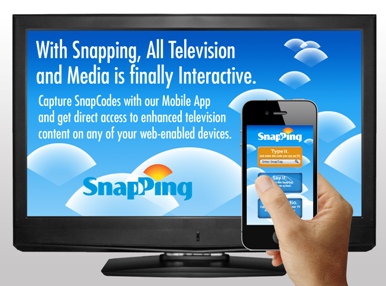Invidi Preps 'SnapPing' TV Tags For Second-Screen Interactivity
Targeted-ad solutions vendor Invidi Technologies has spent two years quietly developing a tagging system, dubbed SnapPing, that promises to let TV advertisers and networks deliver interactive experiences -- without having to go through a set-top box.
Invidi's SnapPing uses an on-screen "SnapTag" to indicate that there is interactive content associated with the TV show or ad. Then, using a phone or tablet device with the SnapPing app, a user identifies the tag using audio, text, voice or image recognition to link to the desired information.
For example, during an NFL game, the network might put up SnapTags to deliver additional player stats to viewers, while a Hollywood studio could embed a tag in an 30-second spot that kicks users to a longer-form version of a movie trailer.

"We're making television interactive without using the cable infrastructure," Invidi president and CEO Dave Downey said. "We wanted to create a companion app not for a show, or a network, but for all of TV -- the whole megillah."
The system hasn't launched yet, but will eventually be accessible through iPads, iPhones, Android devices and at SnapPing.com, according to the company. The second-screen approach addresses several things programmers and marketers hate about conventional interactive TV, Downey said. A smartphone or tablet doesn't obscure the TV screen real estate and provides an environment for richer interactive experiences.
"How can you have a [Motorola] DCT-2000 [set-top] compete with what you can do on an iPad? You can't," Downey said.
Unlike other approaches, such as Shazam for TV, SnapPing lets viewers identify content using a "SnapTag" not only via audio recognition but also speech, text entry and image recognition. Downey said that distinction is crucial: "Our research proves that audio detection is not enough. It is a nonstarter for adults over 35, and it is limited to situations where audio detection can work."
Multichannel Newsletter
The smarter way to stay on top of the multichannel video marketplace. Sign up below.
According to a $250,000 focus group study Invidi commissioned, consumers strongly preferred speaking or texting the SnapTag into a device, with Shazam-style audio recognition a distant third. Invidi is refining the format for the SnapTag, but Downey said it will work with both live or recorded shows.
The Invidi system also will include a "Snap an App" feature, which will let a user install an app after accessing a SnapTag, as well as autotags, which will let a user push one button to get all the interactive content associated with a show.
Still, Invidi's SnapPing will have to contend with Shazam's TV play. The Shazam apps, which originally were designed to ID songs, can now identify the audio in a TV show or ad (which has been ingested and processed ahead of time). Shazam for TV, since launching in February, has reached more than 100 million people and served 5.5 billion impressions, according to executive vice president of advertising sales Evan Krauss. "We have a huge user base," he said.
Advertisers that have aired "Shazamable" ad campaigns include Honda, Starbucks, Paramount Pictures' Transformers 3, Procter & Gamble and Progressive Insurance. Last month, Shazam raised a $32 million round of funding to be used to support Shazam for TV.
Invidi, for its part, has received $111.5 million in funding, from investors including DirecTV, Google, WPP's GroupM, Motorola Ventures, Experian, NBC, Verizon and venture capital firms Menlo Ventures, InterWest Partners, EnerTech Capital, Westbury Equity Partners and BDC Capital.
New York-based Invidi has about 80 employees. Its addressable-advertising system is under contract for 40 million homes with DirecTV, Dish Network and Verizon FiOS.
Invidi is suing addressable-ad rival Visible World and Cablevision Systems, alleging they infringe a patent Invidi owns for delivering addressable ads.
